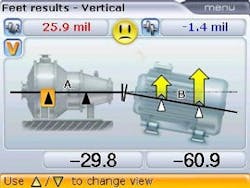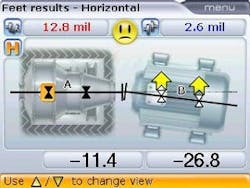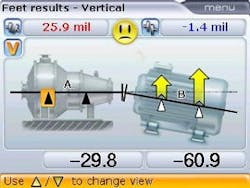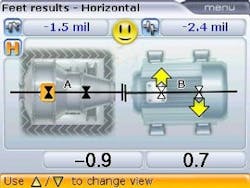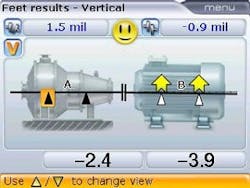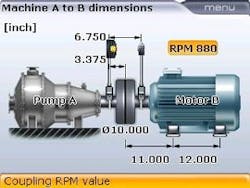Proper alignment helps one plant keep on pumping
Asset component misalignment
The graphical results from the Ludeca Optalign Smart alignment tool show equipment components out of alignment and the results after alignment of the equipment is completed.
The Mill Creek Wastewater Treatment Plant is part of the Metropolitan Sewer District of Greater Cincinnati. Vibration analysis of process equipment in the Mill Creek Primary Sludge Pumping area indicated readings that deviated from the baseline for Pump 5. Vibration testing and analysis were completed by PdM Technician Doug Little. Based on the vibration levels recorded, the technician determined the most likely cause to be misalignment or looseness of the drive belts. Proper alignment and tensioning of drive sheaves and belts is critical to preserving the life expectancy of the drive belts, as well as reducing the stress on the pump and motor, increasing their reliability. Severe misalignment of the drive components will cause high vibration levels and premature failure of pump and motor bearings, leading to unexpected downtime and loss of service for critical process equipment.
A predictive maintenance and reliability (PDMR) follow-up work order was generated, planned and scheduled for Mill Creek Maintenance to replace and properly tension the drive belt and to check the alignment of the motor and pump sheaves. The proactive work was coordinated by Maintenance Planner Rob Johnson, along with Crew Leader Bob Smith. Geoff Sturgill, a Mill Creek plant maintenance worker, correctly aligned the pump and motor sheaves, utilizing the Ludeca SheaveMaster laser alignment tool, which allows maintenance personnel to precisely align both drive sheaves using a laser light and targets, greatly increasing the accuracy of component alignment. After properly tensioning the belts, the pump was post-maintenance tested, confirming that vibration readings had returned to baseline levels.
The total work order costs of vibration testing and follow-up repairs were $419.82. Had the pump bearings failed, the pump would have needed to be rebuilt with a completely new rotating assembly, at an estimated cost of $ 1,887.10, resulting in a conservative cost avoidance of $1,467.28 for replacement components, with additional costs incurred for labor and process downtime.
Extended lifecycle of new asset
Another maintenance find was detected by the Mill Creek South mechanical maintenance staff and Crew Leader Smith, utilizing the Ludeca OptAlign Smart laser alignment tool. Alignment testing and follow-up repairs were completed by plant maintenance workers Chris Oliver, Todd Sharfe and James Boland.
As part of the acceptance and commissioning process for new assets, equipment installed by contractors during capital improvement projects (CIPs) is baseline-tested for proper alignment. During scheduled alignment testing for the new Mill Creek Grit Area process equipment, the technicians discovered that a grit tank drain pump was not correctly aligned when it was installed. Alignment results in the vertical plane showed the pump was 25.9 mils out of alignment, and 12.8 mils out in the horizontal plane.
A follow-up work order was generated, and Mill Creek maintenance workers realigned the equipment, using the OptAlign Smart tool to ensure the motor and pump were aligned within specifications. Misalignment of rotating equipment will lead to premature wear and ultimately a failure of asset components, which reduces the lifecycle of the equipment and causes a loss of process system availability. Finding and correcting misaligned equipment before equipment fails is a critical step toward ensuring that newly installed equipment remains reliable. Had this asset not been properly aligned, the cost for materials and labor to rebuild the pump would be about $3,700, with additional costs associated with the loss of service for this critical process area.
